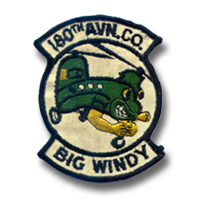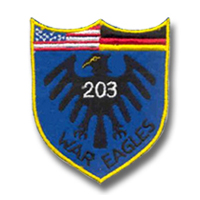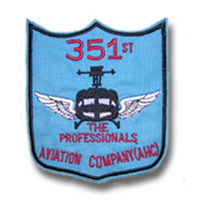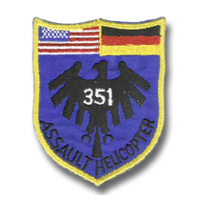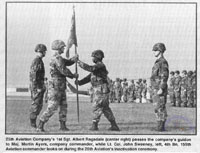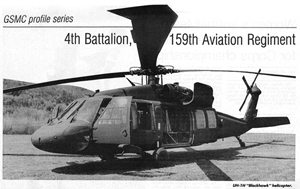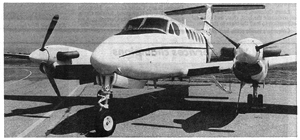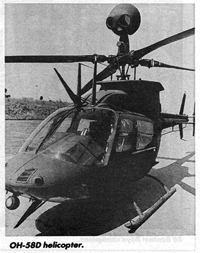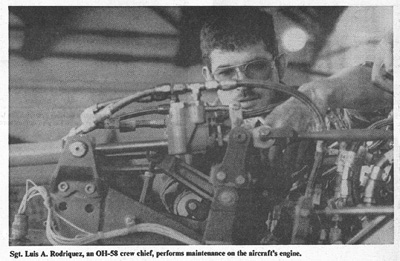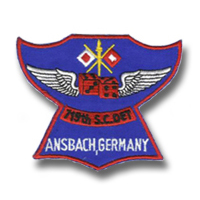| If you do
NOT see the Table of Contents frame to the left of this page, then
Click here to open 'USArmyGermany' frameset |
||||||||||||||||||
|
223rd
Aviation Battalion |
||||||||||||||||||
|
|
||||||||||||||||||
|
||||||||||||||||||
|
|
||||||||||||||||||
| 223rd Avn Battalion History | ||||||||||||||||||
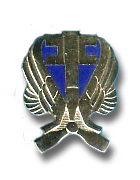 223rd Aviation Bn DUI
223rd Aviation Bn DUI |
||||||||||||||||||
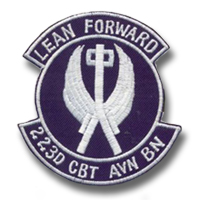 223rd Aviation
Bn Pocket Patch
223rd Aviation
Bn Pocket Patch |
||||||||||||||||||
1972 |
||||||||||||||||||
(Source: STARS & STRIPES, Nov 11 1972) |
||||||||||||||||||
The 16th Aviation Battalion has been redesignated as the 223rd Aviation Battalion. The 223rd consists of The 223rd assumed the mission of the former 16th Avn Bn |
||||||||||||||||||
1974 |
||||||||||||||||||
(Source: Email from Sharon Martin) |
||||||||||||||||||
What fun to find your website! I was assigned to the 223rd Avn Bn in September 1974 and was the third WAC to be assigned there as a Flight Simulator Specialist. Julia Bibbee and Susan Schwinn were already assigned to the unit when I arrived. CPT Ken Gingras was the company commander, SFC Bud Panky ran the S-2, and CSM Burgess was the BN CSM. He and his wife graciously let me stay my first night at their home because the unit had not yet established a female barracks. Julie and Sue were housed with women from other units. As more women arrived at the 223rd, they moved the senior NCOs into the bottom floor of one of the barracks and the women had the top floor. We all shared one latrine. They closed off the urinals and we all used the stalls. It was interesting getting ready in the morning and brushing your teeth next to a guy shaving! The shower room had a lock on the door so that maintained everyone's privacy. It worked well. MAJ Greear was the S-3 and SGT Ron Pixler was my mentor as I transitioned from Flight Simulator to Flight Ops and tracked flight hours and other training. CW4 Freitas and CW4 Roach were the instructor pilots and safety gurus if I remember correctly. CPT Gingras was promoted to MAJ and joined the S-2 shop. In September 1975 when the unit transitioned to the Stuttgart Army Airfield, he and I were on the main advance party. Any idea where he is these days? I'm still in contact with Linda Eggleston who worked in S-2 and Marcia Kohler. I don't remember what section she was in. Other names pop into my mind from the unit: Ron Springer (the BN Commander driver), Candy Clark, Rod Croy (maintenance?), Neil Hendrickson (S-1), CPT Schillereff (company commander after CPT Gingras), "Bing" Von Bergen, Russell White Eyes (who I married in June 1975), Chris Bibbee, Big O Ostrander, Rob Kleiss. I can picture the First Sergant but don't recall his name. I left Germany and the Army in June 1976. I joined the National Guard in 1977 in North Dakota and retired with 28 yrs of service from the ND, MT and SD Guard in Sept 2005. |
||||||||||||||||||
1975 |
||||||||||||||||||
| If you have more
information on the history or organization of the 223rd Aviation Battalion,
please contact me |
||||||||||||||||||
|
|
||||||||||||||||||
| MISCELLANEOUS
UNIT INFORMATION In 1987, the 223rd Avn Bn comprised the following subordinate units: |
||||||||||||||||||
|
||||||||||||||||||
|
|
||||||||||||||||||
|
||||||||||||||||||
| (1) the 351st
Avn Co was redesignated as the 71st Avn Co (sometime in the mid 1970s) (2) 351st Avn Co pocket patch redesigned by SFC Jorge Gonzalez and another member of the unit. |
||||||||||||||||||
| 4th Bn, 159th Aviation History | ||||||||||||||||||
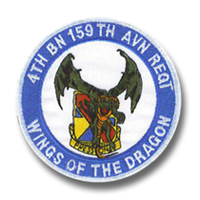 4th Bn, 159th Aviation Patch 4th Bn, 159th Aviation Patch |
||||||||||||||||||
| (Source: Stuttgart Citizen, Nov 7 1988) | ||||||||||||||||||
| Unit inactivated and reactivated in one day By Kevin Hudson The 25th Aviation Company from the Stuttgart Army Airfield was inactivated in a ceremony there Oct. 28, and was reactivated moments later as companies Alpha, Bravo and Delta of the 4th Battalion, 159th Aviation. By directive of a higher headquarters to adopt a regimental system, the soldiers and equipment of the 25th Aviation Company were combined with the soldiers of Headquarters and Headquarters Company, 4th Bn, 159th Aviation, and formed the "Army of Excellence Battalion" of the 159th Aviation. |
||||||||||||||||||
|
||||||||||||||||||
| Assuming command were: Capt Michael L. Roberts, Company A; Capt Edward M. Szeman, Company B; and Capt Jeff G. Wyns, Company D. According to Capt Larry Gissentanna, battalion adjutant, Headquarters and Headquarters Company was activated a year ago, and Company C will be activated when the unit receives its new helicopters, which is expected to be around July 1989. As with the 25th Aviation Company, the 4th Bn., 159th's mission will continue to be to provide readily available aviation support to the commanding general of the VII US Corps, his staff, and major non-divisional subordinate commands throughout the VII Corps area. |
||||||||||||||||||
| (Source: Stuttgart Citizen, Aug 19 1990) | ||||||||||||||||||
| 4th Battalion, 159th Aviation Regiment by Bob Gonsalves They call themselves the "Wings of the Dragon." The Department of the Army calls them 4th Battalion, 159th Aviation Regiment. The aviation unit, stationed at Stuttgart Army Airfield, provides direct air support to VII Corps Headquarters and general support to a number of subordinate commands with its fleet of UH-1 H "Blackhawk" helicopters and C-12C and U-21A fixed wing aircraft. |
||||||||||||||||||
|
||||||||||||||||||
| (Source: Email from Thomas N. Toomey) | ||||||||||||||||||
| I was stationed at the HHC, 223rd Avn BN at Nellingen Bks from 1972-1974. The insignia I have is quite a bit different than what you have posted. Yours is of the early version. The patch also changed from the original proto type you have which is a real collectors item
to a professionally done round patch. I will look and try to find my stuff and scan it in to send you a copy. We were very involved with the German Army in joint Operations. Because of that I won the silver metal in the Leibsubsichen (sp), which is like our PT Test. For the 20 run portion. Lt Rudy Riensprect (BN Executive Officer) and I ran with M60 machine guns, just barely making the time. I also received the Silver metal in the Schützenschnur, which is like the German Army's Expert Infantryman's badge with rifle qualification. The CSM was CSM Burgess and the BN Commander was Col. Coulter at least for some of that time its been a long time ago. I will look some of it up to give you more specific information if you like just let me know. We still had WAC's barracks when I first got there. The VOLAR Army was the in thing. The racial riots were happening everywhere and the big one at the Stuttgart PX. That was the beginning of mandatory Race Relations classes. The Ammo Depot was attacked by the Baader-Meinhof Gang in 1973. I know because I was on guard duty! That night sucked! But no one got hurt, thank God. Also the unit flew out of Echterdingen AAF, Stuttgart. I am trying to find someone who was there with me that can also attest to what happened but so far I can't connect with anyone. |
||||||||||||||||||
| 25th Aviation Company | ||||||||||||||||||
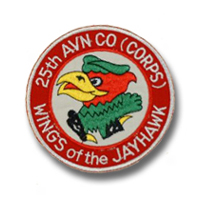 25th Aviation Company Patch 25th Aviation Company Patch |
||||||||||||||||||
| (Source: Stuttgart Citizen, Sept 5 1983) | ||||||||||||||||||
| Aviation unit maintains long safety record 35,000 accident-free flying hours accumulated By C.J. Costello The sign above the door reads "Jayhawk Express. You call, we haul." It sounds like a trucking company but it's actually the motto for the 25th Aviation Company, 223rd Aviation Battalion, 11th Aviation Group in VII Corps. Headquartered in Echterdingen, West Germany near Stuttgart, the pilots fly from Crete to Denmark and from England to Berlin. Their mission includes aviation support to the VII Corps commander, staff, major subordinate commands, and visiting dignitaries. They also provide fixed-wing support to VII Corps' divisions. "Missions may range from flying congressmen in the morning, and that afternoon the same pilots may be doing tactical NOE (nap of the earth) support for an ARTEP," commented CW02 Ronald R. Hendricks, safety officer for the 25th. Professionalism is shown every day in the work quality of the 25th's soldiers. Their job requires people who are alert and safety conscious. Through the teamwork and cooperation of everyone, not just the crews who fly the aircraft, the 25th has logged more than 12 years without a chargeable accident. During that time, they accumulated more than 35,000 flying hours. Recently, nine pilots in the 25th were awarded VII Corps Certificates of Merit for safety. To earn such an award, each pilot flew at least 1,000 accident/incident-free flying hours while assigned to VII Corps. Normally, most Army pilots only fly about 200 flying hours per year, which would make it difficult to accumulate 1,000 flying hours at one unit. Contributing factors There are many factors that contribute to the success of the 25th. The pilots' experience, the crew chiefs' and mechanics' expertise, and even the commander's attitude play a part in the safety record of the aviation company. "The human factor is always an element involved in safety," explained Maj. Gregory R. Jenkins, 25th's commander. "It takes everyone's cooperation to make it a success,not just the safety NCO's and officer's effort," he continued. |
||||||||||||||||||
|
||||||||||||||||||
| Behind the scene Much of the work involved in aviation is hidden behind the scene. Before a passenger boards the aircraft, a series of events must take place. The first step is to contact the man who coordinates the flight. "Here, I schedule missions for everyone in VII Corps," said Sp4 Louis Calahan, flight operations clerk for the 25th. The initial flight proceedings begin when a mission sheet is filled out designating an aircraft and a crew. After the plots pick up their mission sheet, they make a flight plan. Weather conditions, landing area, amount of flying time, fuel consumption, and flight patterns are just a few of the factors considered. Once the plan has been completed, it is filed into a computer system to reserve a spot in the airway system. Another precaution that is taken, especially in the summer when field exercises keep the pilots flying long hours is crew rest time. The 25th has their own crew rest plan which works, according to Hendricks. Before the aircraft is ready for take-off, it is checked out by the pilots and the crew chief. The crew chief knows his aircraft and spends many hours keeping it up to par. "The crew chief is supposed to prepare the aircraft one hour and 15 minutes prior to takeoff," remarked Sgt, Scott .Leitzel, one of the many crew chiefs at the 25th. "After landing, it may take two or three hours to perform the inspections necessary." With a checklist in hand, the crew chief begins examining the aircraft. "In our log book, we have a list of things to be done either on a daily or an hourly basis," demonstrated Leitzel. "Using checklists is mandatory. You don't want to rely on memory. That's when you make mistakes," replied Sgt. Bruce Westfall, the crew chief for the 25th's C-12, one of their fixed-wing aircraft. Mistakes in aviation are costly, especially when one considers that the average flying speed for a C-12 is approximately 280 miles per hour. If something goes wrong on an aircraft, one can't just pull over to the side of the road and fix it like a truck driver can. Inspections, Inspections The aircraft is examined inside and out . . . from the door seals to the front landing wheel. "Every twelve and one-half hours, an oil sample is taken on each engine. It is sent of an oil analysis lab to be examined," continued Westfall. The oil analysis lab can detect minor problems before they become major defects. Once the crew chief has completed his inspection of the aircraft, the pilots begin their inspection. Double checking ensures that all defects, if there are any, are found and corrected before the flight begins. If a stop is made enroute, thru-flight inspections are performed as a precautionary measure. Another inspection is conducted after the flight. The aircraft is serviced and the cycle starts over again. The technical inspectors ensure that the aircraft is safe to fly. "We ensure air-worthiness of the aircraft. It's a daily process. We are also the people pilots can ask maintenance questions and if we don't know the answers, we can find them," stated SSgt. Timothy Fluent, technical inspector for the 25th. Besides examining the aircraft, the technical inspectors also inspect the work environment to make sure safety precautions are used. "We are responsible for the safety conditions of the hangers. We do a monthly inspection to determine work hazards," continued Fluent. These inspections often reveal recurring problems. Every six months the pilots are tested and required to demonstrate certain skills. This test is seldom difficult for the pilots of the 25th. Their wartime mission is the same as their everyday mission - transporting people and cargo from one point to another, safely. (Costello is a journalist assigned to the VII Corps Public Affairs Office,) |
||||||||||||||||||
| 48th Aviation Company / C Co, 7th Bn, 158th Avn | ||||||||||||||||||
| (Source: Jessie Lane, on 48th Aviation Company website, accessed 12-14-2012) | ||||||||||||||||||
| In August 1972, the "Blue Stars" (48th Aviation Company) deployed from Vietnam to Katterbach, West Germany. Upon arrival, the company was assigned to the 223rd Aviation Battalion, VII Corps, at Ansbach Army Airfield. (Webmaster note: actually, only the unit's colors were transferred to Germany. The 349th Aviation Company, already stationed at Katterbach, was deactivated and the new unit, 48th Aviation Company - was reactivated in its place. The personnel and equipment of the old 349th were taken over by the new 48th - a process now known as "reflagging.") In September 1975, the unit moved to Stuttgart Army Airfield (Echterdingen) and Nellingen Barracks. In 1982, the 48th Aviation Company distinguished itself as the Army Aviation Association and USAREUR Aviation Unit of the Year. That same year, the unit had the distinction of being the first aviation unit in Europe to field the UH-60 BLACKHAWK helicopter. In October 1984, the unit was reassigned to the 11th Aviation Battalion, 12th Aviation Group, V Corps, and moved to Wiesbaden (Army Airfield at Erbenheim). In 1986, the "Blue Stars" were deployed on a secret mission to Cyprus, to provide an air bridge for the US Embassy in the war-torn city of Beirut, Lebanon. Elements of the unit continued to perform this mission, operating the "Beirut Air Bridge," until July 1998 (sic). In 1988, the 48th was redesignated as C Company, 7th Battalion, 158th Aviation Regiment. In September 1990, the unit was once again deployed in combat. Attached to the 101st Airborne Division (Air Assault) for Operations Desert Shield and Desert Storm as part of Task Force Griffin, the unit distinguished itself by performing multiple resupply missions and critical long range surveillance team insertions. After the completion of the Gulf War, the "Blue Stars" returned home to Germany with all personnel and aircraft intact. (More on the recent history on the 48th Avn Co website - link) |
||||||||||||||||||
| 1971 | ||||||||||||||||||
| (Source: Email from Bobby Pierce, 349th Avn Co then 48th Avn Co, June 1971 - Dec 1973) | ||||||||||||||||||
| Wow, James Wood brought back a lot of memories. I was stationed at Katterbach from June 1971 thru Dec 1973. I was assigned to the 349th Avn Co. When I got there, Vietnam was starting to phase out and a lot of the soldiers that were stationed in Nam came over to Germany to complete their tour. We had guys sleeping in the basement. We were the only command on that air base. The was one small unit called "D" Troop which I believe they were a part of 1st Armored Div. (Webmaster Note: D Trp, 2nd Sq, 4th Cav - the remainder of the squadron was located at Schwabach.) They flew OH-58 Rangers. The 349th flew Hueys and Cobras. Katterbach was out in the middle of nowhere. There was no housing across the airfield, no school, and no gym. The gym was not built until late 1973. I worked in the supply dept. Our office was in the basement of the barracks. We also had a bar in the basement. The first sergant was SFC Miller. MAJ Harris was CO. Capt Wiederman was XO. My OIC was Lt Dees. SFC Tilka was my NCO. Some of the guys I remember are OHenry from Ind, Wren from St Louis, SP5 Craig Collins from GA, SSG Gatlin, SSG Swiney from Ala. In Aug 1972, the 349th was redesignated the 48th Avn Co. The only thing I noticed changing was our mailing address. Nothing else changed. Sometime in late 1972 or early 1973, the 1st Armored Div moved across HWY 14. I still remember my bed shaking when those tanks got underway for the field (30 days). Stinky's was a guesthouse just outside the gate. There was nothing between Katterbach and Ansbach. Hindenburg Kasene was the place to shop. The PX, commissary, clubs, and theather were there. Hindenburg was in the middle of Ansbach. I understand it does not exist anymore. The Germans have built a mall in its place. I remember going up the hill to Bleidorn and Barton Kasernes. We used to have to go the the bahnhof (train station) to make phone calls back to the States. No cable TV. All we had was AFN radio and that was AM. But the beer was the best I have ever had. The beerfest use to come to town several times a year. It was always fun to be around the locals. One litre of beer was a mark ($.25). The food was great and the rides were fun. Now I'm 56 yrs old and ready to retire from civil service. I would love to get back over the Germany and see how things have changed. ADDITIONAL INFORMATION I know they were AH-1G, single engine and I remember one crashing while doing an auto rotation. The tail hit the ground pretty hard. So far as how we were organized, all I remember was our battalion was the 16th Avn Bn located in Nellingen. Lt Col Coulter was the CO. And at some point the 16th became the 223rd Avn Bn. There was also an avn company at Nellingen that was part of our battalion. I know we flew a lot of troop support with the Hueys and the Cobras provided fire power. Thank you for the opportunity to add to the great history of this battalion. |
||||||||||||||||||
| 1972 | ||||||||||||||||||
| (Source: Email from James Wood, 48th Avn Co, 1972-74) | ||||||||||||||||||
|
||||||||||||||||||
| The local Ansbach
Baader-Meinhoff gang was sighted near Ansbach in 1972, and we actually
went to the field!!! Our Hueys circled around the area they were spotted
in but it seems that they were never caught. 1973 was the year I believe,
that the winter olympics were held in Munich and Garmish. The BN in
Nellingen had a change of command cermony. The 48th sent several Hueys
to the ceremony....BUT only one Huey made it in time.....6 people
were there for the formation from the 48th. I remember in 1973 that six of us went on R&R to Garmish. A bus came from battalion to pick us up. On the return trip, the bus took us to Nellingen Barracks. There was a bad snow storm and the company sent two helicopters up there to pick us up in the middle of the night. There was no POL available so we loaded up and left for Katterbach AAF near Ansbach. We were 30 minutes from Katterbach when the low fuel lights came on. We were worried that we might run out of fuel. We barely made it.... There was a CPT Weiderman who was flying one day and a second acft by his side. His Huey had a halo around it. Must have been the weather. On the airfield/golf course, there were rabbits as big as Texas deer. BUT the German deer was about as big as a German shepard. I built a radio antenna on top of the 48th Avn barracks. We were able to talk to the battalion at Stuttgart but they couldn't talk back. So the battalion commander asked me to come to Stuttgart and build him one for their operations so we could communicate back and forth. It actually worked. I remember one of our pilots was getting married in England. Six Hueys were tasked to take the officers to the wedding. As I remember it, there was a field just outside of Katterbach that was used as a staging area for a number of automobiles, all with USA tags. The helicopters landed there and picked up the passengers, including ladies in evening gowns for the rest of the wedding party... That was the story I was told... I never saw the staging area or the cars.... Richard Stanley from Salt Lake City, Utah, was in Avionics; Gregg somebody; Montgomery from SC; Teddy Phillips from Alabama; Blair from Ft Worth; Loches from Chicago; another man from Puebleo, Colorado; in the 48th was SP4 Dunn, 1967 Americal in Nam; I believe there was a SFC Hanvey in the 48th from Alabama. Many years later I found out that I was kin to him. He got there in late 73. I just can't remember anymore other than the German beer.. I have a partial list somewhere.. Stinky, a German, had a guesthouse just outside the NW perimeter of Katterbach. Across the street were tanks, M113's, you name - it they had it. Think they were the 3rd Armor Div. out of Ansbach. At that time the Gym was a gym. After I left it became a PX. |
||||||||||||||||||
|
|
||||||||||||||||||
| 1981 | ||||||||||||||||||
| (Source: Email from Kevin Whitlock, 48th Avn Co, 1981-83) | ||||||||||||||||||
| I was in the 48th Avn Co from 1981 to 1983 at Nellingen. I was the first 67T (blackhawk crewchief) assigned to the unit. Unfortunately, I arrived about 6 months before the UH60s. I was assigned to the maintenace platoon and spent almost six months working 16 hour days, 6 days a week, getting the UH1s ready to turn in. Things finally settled down when the Blackhawks started arriving. The problem was that all the birds had zero hours and we were trying to stagger them in so they all didn't hit phase inspections at the same time. Trying to keep all our pilots current while keeping the hours staggered on all new aircraft was somewhat challenging. I was transferred to the flight platoon when the first Blackhawk arrived but was not assigned an aircraft. All the aircraft went to existing UH1 crewchiefs, they had seniority and experience if not training. I was able to rack up a lot of flight time however and really enjoyed my time with the Unit. Skill not Luck! was out motto. I wish I could find some of those blue star stickers we had. I left there in 1983 and went on to become one of the early members of the 160th task force at Ft. Campbell when I was assigned to C/158th Avn Bn./101st Abn Div. I forgot one interesting thing. George Bush Sr. (then Vice President) visited Germany and was transported on my aircraft (81-23589) while in country. I was not allowed to crew that mission, It went to a more senior crewchief but it was my bird and I was pretty proud. |
||||||||||||||||||
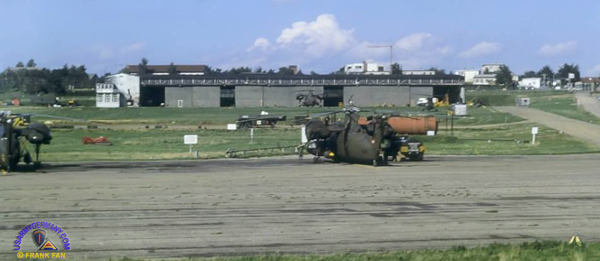 |
||||||||||||||||||
| 1983 | ||||||||||||||||||
| (Source: Email from Jim Goulding) | ||||||||||||||||||
| I was stationed at Nellingen Army Airfield between 1983 to 1984 with the 48th Aviation Company. Our unit had the Blackhawks and our hangars were located next to the 421st Dust-off company. If you look at the picture (above) of the CH-37's that Frank Fan had taken, our unit was located on the right side of the hangar and the 421st were on the left. I think I remember the stairs on the far left went to the operations area and/or briefing room for the Blackhawk EVAC compamy, I think they were the 421st. My company, the 48th Aviation CO (BlueStars) was reassigned shortly after I arrived to V Corps in Wiesbaden around the September of 1983 or 84. I might have some water damaged photographs down in our basement - we lost our house in a fire. I will try to send you what I got. |
||||||||||||||||||
| MISCELLANEOUS
INFORMATION: In August 1972, the 48th Aviation Company was activated in Katterbach, Germany, (1) and assigned to the 223rd Avn Bn. In September 1975, the unit moved to Echterdingen Army Airfield, Stuttgart. In 1982, the 48th was the first army aviation unit in Europe to field the new UH-60 BLACKHAWK. In October 1984, the company was relieved from assignment to the 223rd and reassigned to the 11th Avn Bn, 12th Avn Gp. This reassignment also led to a relocation to Wiesbaden Air Base. In 1987, the unit was redesignated as C Company, 7-158th Aviation Regiment. (1) I believe that the 349th Avn Co was inactivated concurrently and its men and equipment reassigned to the 48th. Can anybody confirm? (See Bobby Pierce's email) |
||||||||||||||||||
|
|
||||||||||||||||||
| Related Links: |
||||||||||||||||||
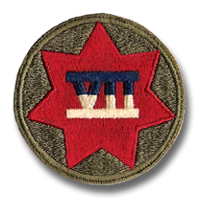
 AHR 1975 400.jpg)
